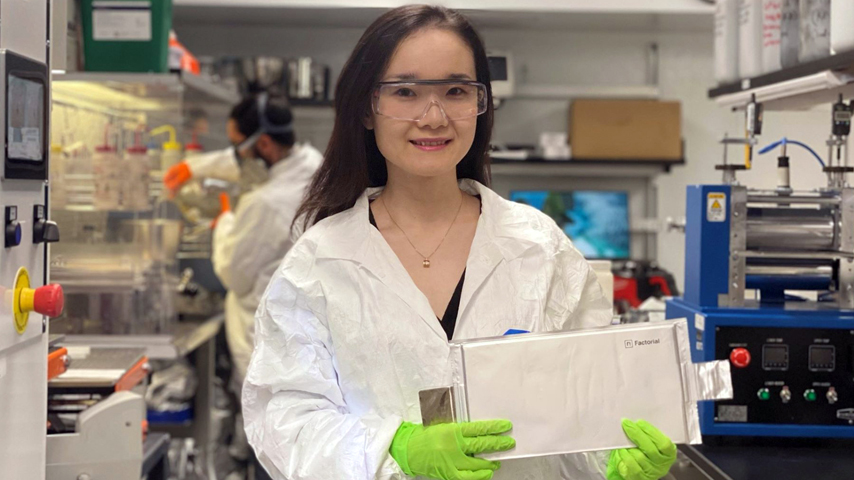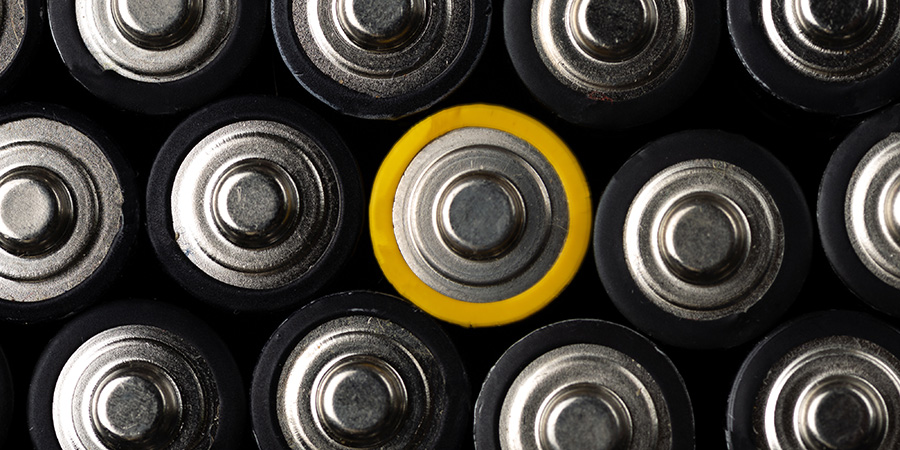A Solid Foundation for Battery Technology
A Solid Foundation for Battery Technology


Batteries that replace the traditional liquid electrolytes with solids are gaining ground in research and early-stage manufacturing pilots.
As the world decarbonizes, researchers and industry are applying an all-hands-on-deck approach to batteries. Sodium-ion replacements for the more popular lithium equivalent is one alternative as extracting lithium becomes more expensive and comes with geopolitical challenges.
Solid-state batteries (SSBs), where all components including traditional liquid electrolytes are solids, constitute a promising alternative to the lithium-ion in use today. “Solid-state batteries hold many unique properties when compared to traditional Li-ion batteries and alternative chemistries,” said Alex Yu, CTO and co-founder of Factorial Energy, manufacturer of solid-state batteries. “The potential for increased safety, range, and energy density make solid-state batteries an attractive option as an energy storage solution for a number of different applications.”
SSBs retain the lithium and direct their focus on using it better by improving the energy density of the battery. A bonus side effect is that the SSBs are non-flammable.
Conventional batteries use a free-flowing liquid electrolyte, which is what conducts ions between the cathode and anode. The cathode and anode have a particular morphology and have a porous separator that prevents the two from touching and the battery from shorting.
Check Out This Infographic: Battery Upgrades Unlocked
While this chemistry has been working well for decades, it’s reaching a plateau in the energy density it can deliver, said Eric Wachsman, professor at the University of Maryland and director of the Maryland Energy Innovation Institute. The upper limit for everyday Li-ion equivalents with a conventional graphite anode is approximately 270 Wh/kg. Solid-state batteries can help push this number higher. Several startups in the SSB space, such as QuantumSpace, promise to get that number to 400 Wh/kg and above.
The advantages of such improved energy density are tantalizing. “A battery with higher energy density gives automotive companies the opportunity to design lighter EVs, also reducing the space required to house the battery components. For customers, it means fewer stops at the charging station and greater freedom to use their vehicles across larger distances,” Yu said.
SSBs replace the liquid electrolyte with one of a few options: polymers, sulfides, and oxides.
Polymer-based solid-state batteries can coast off conventional processing and manufacturing methods but must operate at higher temperatures and borrow energy from the battery itself to do so. This in turn decreases their efficiency.
For their part, sulfides-based solid-state batteries have high conductivities but are not very stable at high voltages or in contact with Li metal anodes. The other disadvantage is that any exposure to moisture can form unwanted hydrogen sulfide gas so batteries will need much more stringent processing conditions, Wachsman pointed out.
A significant advantage of using oxide solids is that they’re not combustible so the batteries become non-flammable and more stable. Such stability enables higher voltage cathodes and Li metal anodes, which in turn increases the energy density of the cell, he said.
The advantages have a cascading effect: Stable chemistries facilitate the use of a lithium-metal anode, which is much lighter than traditional lithium-ion batteries with graphite anodes. “Getting rid of that excess weight and volume can give a battery that has greater energy density,” Wachsman said.
Given that the various categories of solid electrolytes each have their advantages and disadvantages, researchers have a variety of areas to investigate and improve.
Wachsman and his team, for example, are focusing on thinner electrolytes and improved battery capacity. “Most of the solid-state battery work over a few decades now has been focused on thick electrolytes just because that was the way that you could make it in an academic lab,” Wachsman said. The problem with such thick materials, however, is that the resistance increases and you may not get much capacity out of the battery.
Become a Member: How to Join ASME
Wachsman is using a process called tape casting to make these thinner electrolyte materials. A porous support layer provides mechanical strength and allows placement of electrode materials into the pores. The final result is very thin on the order of about 10 to 20 microns, which is the same or better than what's in conventional batteries. The net specific resistance is comparable to or even less, Wachsman added.
While research into SSBs has shown promise, manufacturing attempts are also garnering attention. Factorial’s “quasi solid-state” FEST batteries will be manufactured on equipment “largely similar to the Li-ion battery manufacturing process with a few critical modifications to account for the unique quasi-solid-state battery components,” Yu said. “This allows our technology to be scaled in the short term as proprietary manufacturing equipment is not required, and components for the equipment are readily available.”
Wachsman cautions that manufacturing at scale might present a challenge. "A million cell phones, that's one thing, but a million cars is a whole other level of manufacturing. The rate of scalability of manufacturing [is a bigger challenge] than the rate of development of the technology itself,” he added.
More For You: Battery Storage Is Booming
Once commercialized in electric vehicles there are many secondary markets for solid-state batteries, including energy storage systems, and more. In parallel to EVs, eVTOL (electric vertical take-off and landing) is another application for solid-state cells, Yu said.
Many automotive companies have made significant investments in advancing solid-state battery technology. In 2020, Quantumscape raised more than $1 billion from investors and was expected to start producing SSBs for Volkswagen in 2024. In 2021, Factorial Energy raised $200 million, forging partnerships with Mercedes-Benz, Stellantis, and Hyundai to jointly develop the solid-state battery technology leveraging industry expertise and an automotive OEM perspective.
Poornima Apte is technology writer in Walpole, Mass.

Solid-state batteries (SSBs), where all components including traditional liquid electrolytes are solids, constitute a promising alternative to the lithium-ion in use today. “Solid-state batteries hold many unique properties when compared to traditional Li-ion batteries and alternative chemistries,” said Alex Yu, CTO and co-founder of Factorial Energy, manufacturer of solid-state batteries. “The potential for increased safety, range, and energy density make solid-state batteries an attractive option as an energy storage solution for a number of different applications.”
The energy density factor
SSBs retain the lithium and direct their focus on using it better by improving the energy density of the battery. A bonus side effect is that the SSBs are non-flammable.
Conventional batteries use a free-flowing liquid electrolyte, which is what conducts ions between the cathode and anode. The cathode and anode have a particular morphology and have a porous separator that prevents the two from touching and the battery from shorting.
Check Out This Infographic: Battery Upgrades Unlocked
While this chemistry has been working well for decades, it’s reaching a plateau in the energy density it can deliver, said Eric Wachsman, professor at the University of Maryland and director of the Maryland Energy Innovation Institute. The upper limit for everyday Li-ion equivalents with a conventional graphite anode is approximately 270 Wh/kg. Solid-state batteries can help push this number higher. Several startups in the SSB space, such as QuantumSpace, promise to get that number to 400 Wh/kg and above.
The advantages of such improved energy density are tantalizing. “A battery with higher energy density gives automotive companies the opportunity to design lighter EVs, also reducing the space required to house the battery components. For customers, it means fewer stops at the charging station and greater freedom to use their vehicles across larger distances,” Yu said.
The chemistry of solid-state batteries
SSBs replace the liquid electrolyte with one of a few options: polymers, sulfides, and oxides.
Polymer-based solid-state batteries can coast off conventional processing and manufacturing methods but must operate at higher temperatures and borrow energy from the battery itself to do so. This in turn decreases their efficiency.
For their part, sulfides-based solid-state batteries have high conductivities but are not very stable at high voltages or in contact with Li metal anodes. The other disadvantage is that any exposure to moisture can form unwanted hydrogen sulfide gas so batteries will need much more stringent processing conditions, Wachsman pointed out.
A significant advantage of using oxide solids is that they’re not combustible so the batteries become non-flammable and more stable. Such stability enables higher voltage cathodes and Li metal anodes, which in turn increases the energy density of the cell, he said.
The advantages have a cascading effect: Stable chemistries facilitate the use of a lithium-metal anode, which is much lighter than traditional lithium-ion batteries with graphite anodes. “Getting rid of that excess weight and volume can give a battery that has greater energy density,” Wachsman said.
Thinner structures for improved conductivity
Given that the various categories of solid electrolytes each have their advantages and disadvantages, researchers have a variety of areas to investigate and improve.
Wachsman and his team, for example, are focusing on thinner electrolytes and improved battery capacity. “Most of the solid-state battery work over a few decades now has been focused on thick electrolytes just because that was the way that you could make it in an academic lab,” Wachsman said. The problem with such thick materials, however, is that the resistance increases and you may not get much capacity out of the battery.
Become a Member: How to Join ASME
Wachsman is using a process called tape casting to make these thinner electrolyte materials. A porous support layer provides mechanical strength and allows placement of electrode materials into the pores. The final result is very thin on the order of about 10 to 20 microns, which is the same or better than what's in conventional batteries. The net specific resistance is comparable to or even less, Wachsman added.
Manufacturing and commercialization
While research into SSBs has shown promise, manufacturing attempts are also garnering attention. Factorial’s “quasi solid-state” FEST batteries will be manufactured on equipment “largely similar to the Li-ion battery manufacturing process with a few critical modifications to account for the unique quasi-solid-state battery components,” Yu said. “This allows our technology to be scaled in the short term as proprietary manufacturing equipment is not required, and components for the equipment are readily available.”
Wachsman cautions that manufacturing at scale might present a challenge. "A million cell phones, that's one thing, but a million cars is a whole other level of manufacturing. The rate of scalability of manufacturing [is a bigger challenge] than the rate of development of the technology itself,” he added.
More For You: Battery Storage Is Booming
Once commercialized in electric vehicles there are many secondary markets for solid-state batteries, including energy storage systems, and more. In parallel to EVs, eVTOL (electric vertical take-off and landing) is another application for solid-state cells, Yu said.
Many automotive companies have made significant investments in advancing solid-state battery technology. In 2020, Quantumscape raised more than $1 billion from investors and was expected to start producing SSBs for Volkswagen in 2024. In 2021, Factorial Energy raised $200 million, forging partnerships with Mercedes-Benz, Stellantis, and Hyundai to jointly develop the solid-state battery technology leveraging industry expertise and an automotive OEM perspective.
Poornima Apte is technology writer in Walpole, Mass.

Pulse of the Profession: CAD in 2030
As we enter yet another new epoch of CAD innovation, the lines between design and manufacturing phases will continue to blur.






